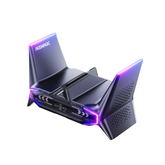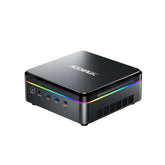LPDDR5 vs DDR5: Performance, Power Efficiency, and Key Differences

Memory technology plays a crucial role in modern electronic devices, directly impacting performance and user experience. DDR5 and LPDDR5, as the most advanced memory standards today, each offer unique advantages for different applications. DDR5 meets the demands of high-performance computing with higher bandwidth and larger capacity, while LPDDR5, with its low power consumption and high energy efficiency, is the top choice for mobile and portable devices. This article will dive into the core features of these two memory technologies and provide a comprehensive comparison to help readers understand how to choose the most suitable memory solution based on their specific needs.
What is LPDDR5?
Basic Concept and Definition of LPDDR5 Memory
LPDDR5 (Low Power Double Data Rate 5) is the fifth generation of low-power, double data rate dynamic random-access memory, designed specifically for mobile devices, Internet of Things (IoT) devices, and automotive infotainment systems that require both low power consumption and high performance. As the successor to LPDDR4, LPDDR5 features several improvements in bandwidth, power efficiency, and performance, aiming to deliver better performance and longer battery life.
Unlike traditional DDR memory, LPDDR5 optimizes power consumption by using lower voltage and advanced memory control technologies, catering to the dual demands of energy efficiency and high performance in mobile devices. The introduction of LPDDR5 enables smartphones, tablets, wearables, and other portable devices to offer smoother user experiences and extended battery life.
Comparison of LPDDR5 vs. LPDDR4
Compared to the previous generation LPDDR4, LPDDR5 introduces several technological innovations, particularly in speed, bandwidth, and power management. Below is a key comparison between LPDDR4 and LPDDR5:
| Technical Parameter | LPDDR4 | LPDDR5 |
|---|---|---|
| Maximum Data Rate | 3200 Mbps | 6400 Mbps |
| Memory Bandwidth | 25.6 GB/s | 51.2 GB/s |
| Maximum Module Capacity | 16GB | 32GB |
| Memory Voltage | 1.1V | 1.05V / 0.9V |
| Memory Channel Width | 64-bit | 16-bit / 32-bit |
As shown in the table, LPDDR5 offers significant performance improvements over LPDDR4. The data rate is doubled from 3200 Mbps to 6400 Mbps, bandwidth is greatly increased, and it supports higher memory capacities and lower power consumption.
DDR5 Memory Explained
Basic Concept of DDR5
DDR5 (Double Data Rate 5) memory is the fifth generation of synchronous dynamic random-access memory (SDRAM), officially released by the JEDEC standards organization in 2020. As the successor to DDR4, DDR5 offers significant improvements in performance and efficiency, designed to meet the modern computing demand for higher bandwidth and larger capacities. The introduction of DDR5 marks a new phase in memory technology, not only boosting data transfer speeds but also enhancing memory stability and reliability. Compared to DDR4, DDR5 is designed with a stronger focus on energy efficiency and multitasking capabilities, making it an ideal choice for high-performance desktops, servers, and high-performance computing systems.
Comparison of DDR5 vs. DDR4
Compared to DDR4, DDR5 introduces important technological innovations that significantly boost performance and efficiency. Below are the key differences between the two:
| Technical Parameter | DDR4 | DDR5 |
|---|---|---|
| Maximum Data Rate | 2133 - 3200 Mbps | 4800 - 8400 Mbps |
| Memory Bandwidth | 25.6 - 25.6 GB/s | 38.4 - 67.2 GB/s |
| Maximum Module Capacity | 16GB | 64GB |
| Per Channel Bandwidth | 6.4 GB/s | 12.8 GB/s |
| Memory Voltage | 1.2V | 1.1V |
| Memory Channel Width | 64-bit | 40-bit |
As shown in the table, DDR5 offers substantial improvements over DDR4 in terms of data rate, bandwidth, and maximum module capacity. Its maximum data transfer rate is considerably higher than DDR4, providing greater bandwidth and capacity to support more complex applications.
Comprehensive Comparison of DDR5 and LPDDR5

Different 1: Performance Comparison
Memory performance is typically determined by factors such as data rate, bandwidth, and latency. Below, we compare the performance differences between DDR5 and LPDDR5.
Frequency and Bandwidth
- DDR5: DDR5 offers higher speeds and bandwidth compared to its predecessor, DDR4. Its base data rate is 4800 Mbps, with a potential to scale up to 8400 Mbps or higher. DDR5 is ideal for applications requiring large data transfers, such as servers and high-end workstations.
- LPDDR5: While LPDDR5's data rate is lower than DDR5, it still achieves a maximum data rate of 6400 Mbps. LPDDR5 is primarily used in mobile devices, prioritizing low power consumption while delivering high bandwidth.
| Standard | Max Data Rate | Applicable Bandwidth Range |
|---|---|---|
| DDR5 | 4800 Mbps - 8400 Mbps | High-performance computing, high-bandwidth applications |
| LPDDR5 | 6400 Mbps | Mobile devices, energy-efficient scenarios |
Latency and Response Time
- DDR5: To achieve higher bandwidth, DDR5 sacrifices some latency. Particularly at higher frequencies, DDR5's latency is slightly higher than that of LPDDR5. Therefore, DDR5 is suitable for applications processing large volumes of data, where latency impact is less critical.
- LPDDR5: LPDDR5 is optimized for lower latency and faster response times compared to DDR5. This makes LPDDR5 more effective in mobile devices, especially for real-time applications like gaming and video playback.
Different 2: Power Consumption and Energy Efficiency
Power consumption is a critical factor in mobile devices and energy-sensitive embedded systems. Here is a comparison between DDR5 and LPDDR5 in terms of power consumption and energy efficiency:
Voltage Requirements
- DDR5: DDR5 operates at a core voltage of 1.1V, which is lower than DDR4's 1.2V but still higher compared to LPDDR5.
- LPDDR5: LPDDR5 uses a more efficient voltage design, with a core voltage of 1.05V and an I/O voltage further reduced to 0.5V. This design significantly enhances energy efficiency, making LPDDR5 better at managing power consumption over extended use.
| Standard | Core Voltage | I/O Voltage |
|---|---|---|
| DDR5 | 1.1V | 1.1V |
| LPDDR5 | 1.05V / 0.9V | 0.5V / 0.3V |
Energy Efficiency Analysis
- DDR5: While DDR5 offers strong performance, its relatively high voltage and frequency result in lower overall energy efficiency. It is less suitable for power-sensitive applications.
- LPDDR5: LPDDR5 achieves higher energy efficiency through technologies like Dynamic Voltage Scaling (DVS) and Dynamic Frequency Scaling (DFS). In mobile devices, LPDDR5 can significantly reduce power consumption while maintaining high bandwidth, thus extending battery life.
Conclusion: For devices requiring prolonged use or in mobile environments, LPDDR5 is undoubtedly the more energy-efficient choice.
Different 3: Capacity and Scalability
DDR5 and LPDDR5 differ significantly in terms of memory capacity and system scalability. DDR5 supports much larger single-module capacities, typically ranging from 16GB to 64GB, making it ideal for high-performance computing and large-scale systems, such as data centers and workstations. In contrast, LPDDR5's single-module capacities are smaller, typically ranging from 2GB to 32GB, and are aimed at power-sensitive mobile devices.
In terms of system scalability, DDR5 supports more memory channels and higher bandwidth, suitable for complex multitasking and high-load applications. LPDDR5 typically supports fewer memory channels, making it more suited for resource-constrained devices like smartphones and tablets.
Different 4: Application Suitability
The choice between DDR5 and LPDDR5 depends not only on performance requirements but also on the type of device and its application scenario.
Best Choice for Different Devices
- DDR5: Ideal for devices requiring high performance, high bandwidth, and large memory capacity, such as workstations, desktop computers, high-end servers, and gaming consoles.
- LPDDR5: Best suited for devices with strict power consumption requirements and a need for high bandwidth, such as smartphones, tablets, low-power Mini PCs, automotive infotainment systems, and embedded systems.
Specific Application Scenarios
- DDR5: Perfect for high-end applications that process large volumes of data, such as video editing, 3D rendering, scientific computing, big data analytics, and AAA gaming.
- LPDDR5: Excellent for mobile devices, wearables, IoT devices, and autonomous vehicles, where energy efficiency and long battery life are paramount.
Pros and Cons Analysis
When choosing between DDR5 and LPDDR5, it is important to understand their respective advantages and disadvantages. Each memory type has its unique strengths and limitations, and based on different application requirements, you can make the best choice for your needs.
Pros and Cons of DDR5
Advantages:
DDR5 offers excellent performance and scalability, making it ideal for applications that require high bandwidth and large memory capacity, such as data centers, workstations, and high-performance Mini PCs. DDR5 supports higher memory frequencies (up to 8400 Mbps), allowing it to handle larger data flows, significantly boosting system computational power. Additionally, DDR5 modules can reach up to 64GB, meeting the demands of large-scale memory, making it suitable for tasks that require extensive data caching and complex calculations. The most important advantage is that DDR5 supports plug-and-play modules, making it easy to upgrade and replace, ensuring future memory expansion.
Disadvantages:
Although DDR5 provides outstanding performance, it comes with higher power consumption and costs. Compared to LPDDR5, DDR5 requires a higher voltage (1.1V), resulting in lower energy efficiency. This is particularly noticeable during long-term usage, where it may negatively impact the battery life of mobile devices. Moreover, DDR5 tends to be more expensive, especially for higher-capacity and high-frequency versions. As a result, DDR5 may not be the best choice for users on a budget or those with strict power consumption requirements.
Pros and Cons of LPDDR5
Advantages:
The primary advantage of LPDDR5 is its low power consumption, making it perfect for mobile devices and portable computing platforms. With a low core voltage (1.05V) and dynamic voltage scaling technology, LPDDR5 significantly extends device battery life. In applications like smartphones, tablets, and automotive infotainment systems, LPDDR5 offers sufficient bandwidth and performance while maintaining low power usage, enhancing overall device energy efficiency.
Disadvantages:
While LPDDR5 excels in energy efficiency, its bandwidth and capacity are relatively lower. The maximum supported memory frequency is 6400 Mbps, while DDR5 can go up to 8400 Mbps. Furthermore, LPDDR5 modules typically range from 2GB to 32GB, far below the 64GB limit of DDR5. This makes LPDDR5 unsuitable for high-performance computing tasks that require large memory capacities. Additionally, LPDDR5 does not support plug-and-play modules like DDR5; it is usually soldered directly onto the device's PCB, making it impossible to easily upgrade or replace the memory modules. This can be a limitation for users who want to upgrade their device's memory in the future.
Conclusion: How to Choose

DDR5 and LPDDR5 each have advantages in terms of performance, power consumption, and use cases. DDR5 is suited for high-performance needs, such as desktop systems and servers that require high bandwidth and large memory capacity, supporting greater memory expansion and higher frequencies. On the other hand, LPDDR5 focuses on low-power design, making it ideal for mobile devices and applications where battery life is a critical factor. The low power consumption of LPDDR5 also results in lower heat output, helping to keep device temperatures low and avoid overheating.
Based on your needs, if you require high performance and scalability, DDR5 is the better choice. If battery life, portability, and temperature control are more important, LPDDR5 is the more suitable option.
Related Articles
DDR5 vs LPDDR5X: Speed, Gaming Performance & Which is Better
DDR4 vs DDR5 RAM: Comprehensive Comparison Guide
Related technical articles and reference links
1. JEDEC DDR5 Memory Standard - [Link]
2. LPDDR5 Specificatio - [Link]
3. DDR5 Memory Technology Overview - Micron - [Link]
4. LPDDR5: The Future of Mobile Memory - Samsung - [Link]
FAQs About DDR5 vs LPDDR5
Q1: What is the main difference between DDR5 and LPDDR5?
The main difference between DDR5 and LPDDR5 lies in their design goals and use cases. DDR5 is aimed at desktop systems, servers, and high-performance computing, offering higher data transfer speeds and larger memory capacities. On the other hand, LPDDR5 focuses on low power consumption, making it ideal for mobile devices, smartphones, and other portable products, providing sufficient performance while extending battery life.
Q2: Why does DDR5 consume more power?
DDR5 consumes more power primarily due to its higher operating voltage (1.1V) and support for higher frequencies and bandwidth, designed to meet the demands of high-performance computing. In contrast, LPDDR5 uses a lower voltage (1.05V) and optimizes energy efficiency through low-power design and dynamic voltage adjustment technology, making it better suited for mobile devices.
Q3: Does LPDDR5 perform worse than DDR5?
While LPDDR5 does not match DDR5 in data rate and bandwidth, it has the advantage of lower power consumption. LPDDR5's maximum data rate is 6400 Mbps, while DDR5 can reach 8400 Mbps or higher. LPDDR5 is ideal for power-sensitive devices, whereas DDR5 is designed for high-performance systems.
Q4: Is DDR5 suitable for mobile devices?
While DDR5 offers higher performance and bandwidth, its higher power consumption makes it less suitable for mobile devices. LPDDR5 is specifically designed for mobile devices, providing high performance while better managing power consumption, thereby extending battery life.
Q5: Can LPDDR5 memory modules be upgraded or replaced?
Since LPDDR5 is typically soldered directly onto the device's PCB, users cannot easily upgrade or replace memory modules like they can with DDR5. LPDDR5 is better suited for devices that require low power consumption and long-term stability, with minimal need for memory expansion.
Q6: Which memory is better for high-end gaming and video editing?
For high-end gaming and video editing tasks that demand high-performance computing, DDR5 is more suitable. It provides larger bandwidth, higher frequencies, and greater memory capacity, meeting the high-performance requirements of these tasks.
Q7: Does DDR5 support overclocking?
DDR5 does support overclocking, but it can affect system stability and power consumption. Overclocking is typically recommended for experienced users who are comfortable with adjustments. Proper cooling and power supply are necessary when overclocking to prevent overheating or system instability.







Leave a comment
Please note, comments need to be approved before they are published.